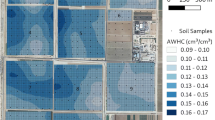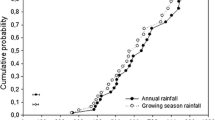Abstract
With over 4 million ha irrigated cropland, the Lower Mississippi River Valley is a highly productive agricultural region where irrigation practices are similar and the Mississippi River Valley alluvial aquifer (MRVA) serves as a primary source of on-demand irrigation. The power conversion coefficient method was used to measure season-long irrigation applied by producers to cotton, maize, rice, and soybean grown in the Mississippi Delta over a 12-year period that spanned a range of weather and cropping conditions. Averaged across all years and irrigation methods, irrigation rates were 9200, 3100, 2800, and 1800 m3 ha−1 for rice, maize, soybean, and cotton, respectively. Pivot and flood methods resulted in the lowest application rates when compared to furrow irrigation of row crops. In terms of rice, zero-grade fields received the least irrigation while multiple-inlet rice irrigation reduced irrigation by 19% relative to cascade flooding. No differences were measured between contour- and straight-levee rice fields. Irrigation rates for cotton and rice remained unchanged over time. Maize-soybean rates increased by approximately 200 m3 ha−1 y−1 and correlated (r > 0.67) with cumulative moisture deficit at Stoneville. Study results provide irrigation rates necessary to calculate detailed water budgets for the MRVA. These data may also serve as benchmarks for irrigation performance evaluations.






Similar content being viewed by others
References
Arkansas Natural Resources Commission (ANRC) (2016) Arkansas groundwater protection and management report for 2015. https://static.ark.org/eeuploads/anrc/FINAL_DRAFT_groundwater_rpt_2015-2016.pdf. Accessed 14 March 2016
Arthur JK (2001) Hydrogeology, model description, and flow analysis of the Mississippi River Alluvial Aquifer in Northwestern Mississippi: U.S. Geological Survey Water-Resources Investigations Report 01-4035, p 47
Barlow J, Clark B (2011) Simulation of water-use conservation scenarios for the Mississippi Delta using an existing regional groundwater flow model: U.S. Geological Survey Scientific Investigations Report 2011–5019. p 14. http://pubs.usgs.gov/sir/2011/5019/pdf/2011-5019.pdf. Accessed on 14 March 2016
Black R, Hutchison S, Warshaw C (2004) Economic profile of the lower mississippi river region. Industrial Economics, Inc., Cambridge, p 02140
Bruns HA (2011) Comparisons of single-row and twin-row soybean production in the Mid-South. Agron J 103:702–708
Counce PA et al (2000) A uniform, objective and adaptive system for expressing rice development. Crop Sci 40:436–443
Crowther F (1934) Studies in growth analysis of the cotton plant under irrigation in the Sudan. I. The effects of different combinations of nitrogen applications and water supply. Ann Bot 48:877–914
Dash RG et al (1999) Comparison of two approaches for determining ground-water discharge and pumpage in the lower arkansas river basin, Colorado, 1997–98. U.S. GEOLOGICAL SURVEY. Water-Resources Investigations Report 99–4221. p 39. http://pubs.usgs.gov/wri/wri99-4221/pdf/wrir99-4221.pdf. Accessed 14 March 2016
Evett SR, Vories ED (2014) Irrigation challenges in the sub-humid US Mid-South. Int J Water 8:259–274
Evett S, Carman D and Bucks D (2003) Expansion of irrigation in the mid south United States: Water allocation and research issues. In Proceedings, 2nd international conference on irrigation and drainage, water for a sustainable world—limited supplies and expanding demand, May 12–15, 2003. U.S. Committee on Irrigation and Drainage, Phoenix, pp 247–260
Hanson BR, Schwankl LJ (1998) Error analysis of flowmeter measurements. J Irrig Drain Eng 124(5):248–256
Heatherly LG (1999a) Soybean irrigation, chapter 9. In: Heatherly LG, Hodges HF (eds) Soybean production in the midsouth. CRC Press, Boca Raton
Heatherly LG (1999b) Early soybean production system (ESPS), chapter 8. In: Heatherly LG, Hodges HF (eds) Soybean production in the midsouth. CRC Press, Boca Raton
Heatherly LG, Ray JD (2007) Soybean and corn, chapter 14. In: Lascano RJ, Sojka RE (eds) Irrigation of agricultural crops. Agronomy monograph no. 30, 2nd edn. ASA-CSSA-SSSA, Madison
Henry CG et al (2016) Annual irrigation water use for Arkansas rice production. J Irrig Drain Eng 142(11):05016006
Henry C et al (2015) Water management, Chapter 10 in the arkansas rice production handbook, MP192. University of Arkansas, Division of Agriculture, Research and Extension. http://www.uaex.edu/publications/pdf/mp192/mp192.pdf. Accessed 30 Dec 2015
Huitink G, Tacker P (2000) Drainage and tillage, Chapter 6 in the arkansas soybean production handbook. University of Arkansas Cooperative Extension Service publication MP197. http://www.uaex.edu/publications/pdf/mp197/chapter6.pdf. Accessed 14 March 2016
Hurr RT, Litke DW (1989) Estimating pumping time and ground-water withdrawals using energy consumption data: U.S. Geological Survey Water-Resources Investigations 89–4107. 27 p. http://pubs.usgs.gov/wri/1989/4107/report.pdf. Accessed 14 March 2016
Institute SAS (2010) SAS/STAT 922 user’s guide. SAS Inst, Cary
Martin DL et al (2011) Evaluating Energy use for pumping irrigation water. In Proceedings of the 23rd annual central plains irrigation conference, Burlington, CO., February 22–23, 2011. https://www.ksre.k-state.edu/irrigate/oow/p11/Kranz11a.pdf. Accessed 14 March 2016
Massey J et al (2012) Side-inlet rice irrigation training video. Mississippi State University Cooperative Extension Service. http://www.youtube.com/watch?feature=player_embedded&v=XR2JNspMXkk
Maupin MA, Barber NL (2005) Estimated withdrawals from principal aquifers in the United States 2000. US Geological Survey Circular 1279, Reston
Maupin MA (1999) Water-Resources Investigations Report 99–4175. methods to determine pumped irrigation-water withdrawals from the snake river between upper salmon falls and swan falls dams, idaho, using electrical power data, 1990–95. US Geological Survey, Water-Resources Investigations Report 99–4175. 34 p. https://pubs.er.usgs.gov/publication/wri994175. Accessed 14 March 2016
McDougall W (2015) A pump monitoring approach to irrigation pumping plant performance testing. M.S. Thesis. Department of Biological and Agricultural Engineering. University of Arkansas. 120 p
Miller T (2008) Mississippi’s rice growers guide. Publication 2255. Mississippi State University Extension Service. http://msucares.com/pubs/publications/p2255.htm
Mississippi Department of Environmental Quality (MDEQ) (2016) Delta metering program. https://www.deq.state.ms.us/. Accessed 27 February 2016
Pringle HC (1994) Minimum water requirements for rice grown in the mid-south. Technical completion report project number G2028–06, Year 3. Water Resources Research Institute. Mississippi State University
Reba ML et al (2014) A retrospective review of cotton irrigation on a production farm in the Mid-South. J Cotton Sci 18:137–144
Rhoton FE, Tyler DD, and Lindbo DL (1996) Fragipan soils in the Lower Mississippi River valley: their distribution, characteristics, erodibility, productivity, and management. USDA Agric Res Service. 137:1052–5386. 19 p
Ross J et al (2008) Cultural practices. Chapter 2 in corn production handbook. University of Arkansas Cooperative Extension Service publication MP437. https://www.uaex.edu/publications/pdf/mp437/mp437.pdf. Accessed 14 March 2016
Saucier RT (1994) Geomorphology and quaternary geologic history of the Lower Mississippi Valley, vol I. U.S Army Engineer Waterways Experiment Station, Vicksburg, p 414
Schaible GD, Aillery MP (2012) Water conservation in irrigated agriculture: trends and challenges in the face of emerging demands, EIB-99. U.S Department of Agriculture, Economic Research Service, Washington, p 60
Schwartz D et al (2013) The Hawthorne effect and energy awareness. Proc Nat Acad Sci 110(38):15242–15246
Silva M (2016) Delta Agricultural Weather Center. Mississippi State University Extension Service. Stoneville, Mississippi. http://www.deltaweather.msstate.edu/. Accessed 11 July 2016
Smith MC et al (2007) Water use estimates for various rice production systems in Mississippi and Arkansas. Irrig Sci 25:141–147
Snipes C et al (2005) Current agricultural practices of the mississippi delta. Bulletin 1143. Mississippi Agricultural and Forestry Experiment Station. 21 p. http://msucares.com/pubs/bulletins/b1143.pdf. Accessed 27 February 2016
Stoker DM (2011) Ultrasonic flow measurement for pipe installations with non-ideal conditions. Masters of Science Thesis. Civil and Environmental Engineering. Utah State University. http://digitalcommons.usu.edu/etd/1060. Accessed 27 February 2016
Tacker P, Vories E (2000) Irrigation, chapter 8 in the arkansas soybean production handbook. University of Arkansas Cooperative Extension Service publication MP197. http://www.uaex.edu/publications/pdf/mp197/chapter8.pdf. Accessed 14 March 2016
Tacker P et al (2008) Drainage and irrigation. Chapter 3 in corn production handbook. University of Arkansas Cooperative Extension Service publication MP437. https://www.uaex.edu/publications/pdf/mp437/mp437.pdf. Accessed 14 March 2016
Thomas J et al (2004) Multiple inlet irrigation for rice. Publication 2338. Mississippi State University Extension Service. http://msucares.com/pubs/publications/p2338.pdf. Accessed 27 February 2016
Thomas JG (1986) Irrigation system selection. Publication 1508. Mississippi State University Cooperative Extension Service. http://msucares.com/pubs/publications/p1508.htm. Accessed 23 February 2016
Thomas JG (2015) Rice flood guide, form 810. Mississippi State University Cooperative Extension Service. http://msucares.com/pubs/forms/f810.htm. Accessed 30 Dec 2015
Thomas JG, Blaine A (2015) Soybean irrigation. Mississippi State University Extension Service publication 2185. http://msucares.com/pubs/publications/p2185.htm. Accessed 31 Dec 2015
US Geological Survey (2009) Arkansas, Louisiana, and Mississippi (HA 730-F) in Ground water atlas of the United States. http://pubs.usgs.gov/ha/ha730/ch_f/F-text2.html. Accessed 22 February 2016
USDA, National Agricultural Statistics Service (2003) 2002 Census of agriculture, farm and ranch irrigation survey. http://www.agcensus.usda.gov/. Accessed 31 Dec 2015
USDA, National Agricultural Statistics Service (2013) 2012 Census of agriculture, farm and ranch irrigation survey
USDA, National Agricultural Statistics Service (2015) Prices received: Soybean Prices Received by Month, US. http://www.nass.usda.gov/Charts_and_Maps/Agricultural_Prices/pricesb.php
USDA Economic Research Service (2015) U.S. agricultural exports, state detail by commodity. Calendar years 2000–2014. http://www.ers.usda.gov/data-products/state-export-data.aspx. Accessed 22 February 2016
USDA Natural Resources Conservation Service (NRCS) (2014) Precision land forming, Conservation Practice Standard Code 462. http://www.nrcs.usda.gov/Internet/FSE_DOCUMENTS/nrcs143_026087.pdf. Accessed 14 March 2016
Vories ED et al (2005) Multiple-inlet approach to reduce water requirements for rice production. Am Soc Agri Eng 21:611–616
Yazoo Mississippi Delta Joint Water Management District (YMD) (2013) Annual Summary. http://www.ymd.org. Accessed 19 April 2016
Yazoo Mississippi Delta Joint Water Management District (YMD) (2014) Annual Summary (available upon request)
Young JR (2014). Arkansas Water Plan Update 2014. Summary. Arkansas Natural Resources Commission. Pg. 6. http://www.arwaterplan.arkansas.gov. Accessed 19 April 2016
Acknowledgements
The authors gratefully acknowledge the support provided by YMD staff and Board of Commissioners. The assistance of L. Pringle, Mississippi State University Delta Research and Extension Center, Stoneville, MS; A. Adviento-Borbe and M. Reba, USDA ARS Delta Water Management Research unit-Arkansas State University; M. Anders, University of Arkansas-Rice Research and Extension Center, Stuttgart, AR (retired); and P. Rodrigue, USDA NRCS, Greenwood, MS, is also gratefully acknowledged.
Author information
Authors and Affiliations
Corresponding author
Ethics declarations
Conflict of interest
No conflict of interest.
Disclaimers
The USDA and YMD are equal opportunity providers and employers. Use of trade, firm, or corporation names in these methods is for the information and convenience of the reader. Such use does not constitute an official endorsement or approval by the Yazoo Mississippi Joint Water Management District or the U.S.D.A. Agricultural Research Service, of any product or service to the exclusion of others that may be suitable.
Additional information
Communicated by K. Stone.
Rights and permissions
About this article
Cite this article
Massey, J.H., Mark Stiles, C., Epting, J.W. et al. Long-term measurements of agronomic crop irrigation made in the Mississippi delta portion of the lower Mississippi River Valley. Irrig Sci 35, 297–313 (2017). https://doi.org/10.1007/s00271-017-0543-y
Received:
Accepted:
Published:
Issue Date:
DOI: https://doi.org/10.1007/s00271-017-0543-y




